|
Nothing says 'desert' like an Agave. For fanciers of desert plants, this genus needs no introduction, bringing to mind a stiff, succulent rosette of outstanding beauty and structural form. This is the essence of Agave - exquisite rosettes in an infinite variety of shapes, sizes, colors and textures. Others will know Agave for the spectacular giant panicles of flowers that are produced when the plant reaches a certain age. While plant explorations in Mexico have resulted in the discovery and introduction of many interesting Agaves that were previously unknown, it would be a pity to forget about all the fabulous Agave species native to the United States. So I have written this article to inform you about them and describe how cool they are.

Agave arizonica, cultivated at Tilden Regional Park, Berkeley, California.
|
The number of Agave species native to the United States depends upon how you count them, but at the very least, one would have to count 18 US native Agaves. Various Agaves are native to 7 of the 50 US states. The greatest diversity of Agaves in the US is found in the state of Arizona, home to 12 species, many of which have several forms and subspecies. The most northerly occurring Agave is A. utahensis subsp. utahensis, which is the only species native to Utah (as you might guess from the name). The most westerly occurring species is A. shawii subsp. shawii in the San Diego area. However, A. utahensis var. eborispina comes almost as far west in the mountains east of Death Valley, California, making it the most northwesterly Agave.
A. arizonica. Coming from a small area of central Arizona, this species may be of hybrid origin. An attractive plant forming small rosettes of dark blue-green leaves to 1' across, It is very rare in cultivation, but it ought to be hardy in much of the Pacific Northwest (to at least 0°F).

Agave chrysantha in habitat, Sierra Ancha, Arizona.
|
A. chrysantha - Golden-flowered Agave. Usually seen as a silvery or blue-green, somewhat open rosette to 3 - 5 feet across, this species is found in the mountains of central Arizona from about 2,500 to 6,500' and is closely related to A. palmeri. It is attractive, vigorous and very easy to grow, and deserves much more attention from gardeners than it receives. Hardy to about 0 - 10°F.
A. deserti. One wonders what inspired botanist George Engelmann to come up with the immensely clever botanical name for this plant. Indeed, it does grow in the desert, including some of the hottest parts of southern California, southwestern Arizona and adjacent northwestern Mexico. This species varies widely in its appearance and hardiness, and probably only the hardiest forms are worth attempting in the Pacific Northwest. The most common subspecies deserti from south-central California and adjacent Baja California has a tendency to offset prolifically, sometimes forming large colonies.
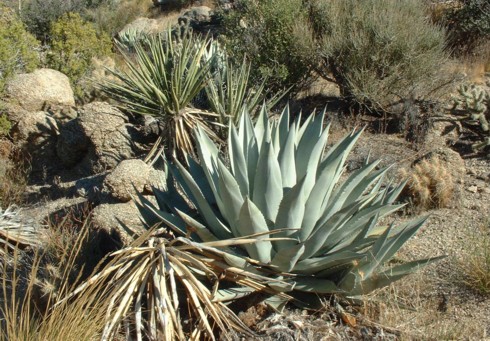
Agave deserti subsp. deserti in habitat, San Jacinto Mountains, California.
|
It has pale silvery (occasionally greenish-silver) leaves which may be 1 - 3 feet long and 2 -5 inches wide. A typical rosette would measure 2' high and wide or less, but the San Jacinto Mountains are home to some larger and hardier forms. This subspecies is rather vigorous in cultivation and not difficult to grow. The subspecies simplex is usually solitary or produces few offsets and is the predominant form found in Arizona and in some of the mountain ranges in the Mojave Desert of southeastern California. They frequently have very strong horizontal banding on the leaves, a striking feature. It is a relatively slow grower and appreciates dry, gritty soil and heat. A third subspecies pringlei from Baja California has the same profusely offsetting habit as deserti but with greener leaves. As its occurrence includes some ocean-facing slopes at rather high altitudes, it ought to do well in the Pacific Northwest also. With such a variable group of plants it is difficult to generalize about cold hardiness. One might guess the best forms are hardy to about 0°F but some southern, low altitude forms might freeze dead at 20°F. The first two subspecies include some very attractive ornamental forms, leading one to wonder why this species has largely been overlooked by cacti and succulent enthusiasts.
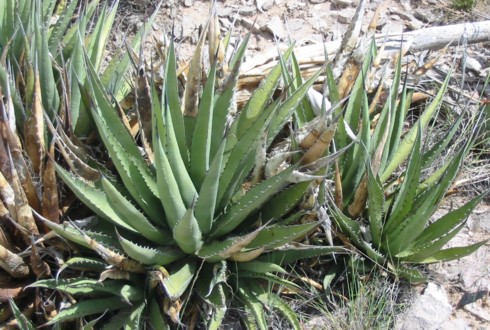
Agave gracilipes near Alamagordo, New Mexico. Photo courtesy of Steve Smullen.
|
A. gracilipes. This odd, variable species from Texas, New Mexico and northern Mexico is thought to have some sort of mixed ancestry representing an intermediate form between A. lechuguilla and A. neomexicana. Interestingly, though, its range extends at least 100 miles north of the native range of A. lechugilla. It is an attractive plant, usually having dull green or grey-green leaves with variable spination, forming a clump of several rosettes or sometimes a large colony. Rosettes may range in size from a little more than 1' to almost 3' across and may be dense or open. Although it is one of the hardiest Agaves, showing impressive tolerance of both cold and wet conditions; it has been overlooked for a long time by most gardeners and remains rare, though it is becoming more available. Hardy to -15°F.

Agave havardiana, large form in habitat, Chisos Mountains, Texas.
|
A. havardiana. An attractive plant looking like a version of A. neomexicana with much broader, flatter leaves in a more open, usually solitary rosette. It originates in Texas and northern Mexico and is represented by several forms. Selections from the Davis Mountains in west Texas, the most commonly offered in nurseries, are quite cold hardy (to at least -10°F) and usually remain compact, growing no larger than 3' across (perhaps 4' in cultivation). Selections from the Big Bend area in Texas and adjacent northeastern Mexico are very robust, impressive plants growing to almost 6' across with huge, fat, silvery leaves. Unfortunately these plants are not as cold hardy, nor are they easy to find in nurseries. Despite being promoted as one of the best hardy Agaves for cold and wet climates, it seems to have an aversion to excessive winter moisture: west of the Cascades, it is probably best with a rain cover, and should be attempted with caution and superb drainage out in the open.
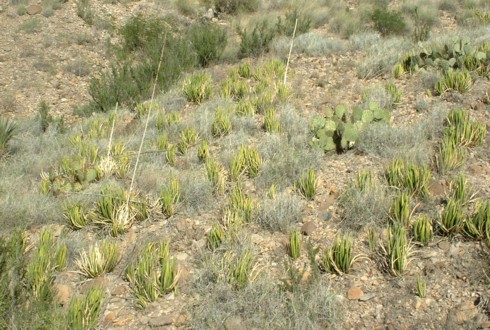
A large colony of Agave lechuguilla in habitat, Big Bend National Park, Texas.
|
A. lechuguilla - Lechuguilla. This species grows over a very broad area of west Texas, southern New Mexico and Mexico, and is considered a primary indicator plant of the Chihuahuan Desert ecosystem. It is a low growing species with narrow, green to grey-green, spine-tipped leaves to about 2'. The leaves usually have varying markings and vertical stripes of lighter and darker green: on some forms this feature is so exaggerated that the leaves appear almost translucent. It forms large colonies over time, and needs space to spread in the garden, though it is a slow grower in cool climates. Some glaucous forms are known from Mexico; these should be introduced to cultivation. As this species has such a large native range, its hardiness varies greatly according to plant provenance: selections from New Mexico are known to endure temperatures down to -10°F, but selections from the southern part of its natural range, and lower altitudes, are certainly much less cold hardy. It should adapt well to milder areas east of the Cascades as well as west.
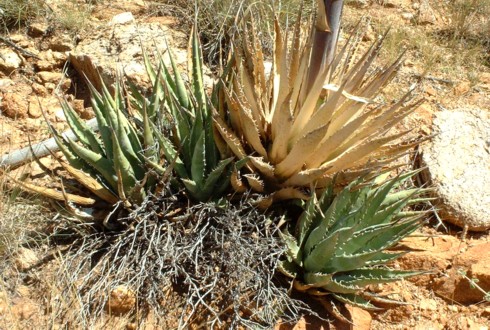
Agave mckelveyana in habitat, Hualapi Mountains, Arizona.
|
A. lophantha. This species from extreme south Texas and adjacent northeastern Mexico forms attractive, open rosettes of deep green leaves. It is a moderate grower and is usually seen as a solitary plant about 2' across, or with one or two offsets, though it may offset prolifically. It is quite moisture tolerant and endures temperatures down to at least 5°F.
A. mckelveyana. A small Agave from mountainous areas of northwestern Arizona at moderate elevations. It is an attractive plant forming an open rosette of blue-green or grey-green leaves. Individual rosettes may reach 2' wide at the most, and they may or may not form offsets. Easily grown and very cold hardy, it remains undeservedly rare in cultivation. It can handle at least -10°F, perhaps lower in dry climates.
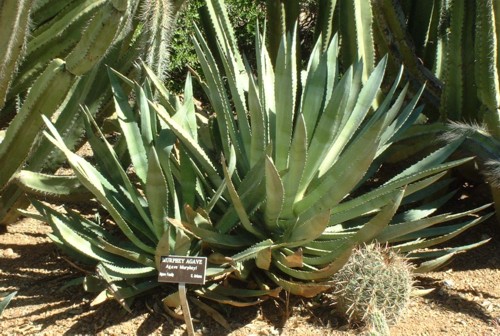
Agave murpheyi, cultivated at the Boyce-Thompson Arboretum, Superior, Arizona.
|
A. murpheyi. From a few sites east of Phoenix, Arizona, this Agave is one of several species thought to have survived the ages largely because Native Americans cultivated it as a food source. (Two other species from Arizona, A. delamateri and A. phillipsiana, share a similar story: these are very attractive plants that at the time of this writing remain extremely difficult to find in cultivation.) A. murpheyi is an attractive, symmetrical plant about 3" in diameter with soft, small-toothed, pale blue leaves. After flowering, which occurs relatively early in the plant's life, the plant puts out numerous bulbils on the flower stalks: it seldom produces seed. It is easily grown and hardy to around 15°F once well established, perhaps lower in dry climates.
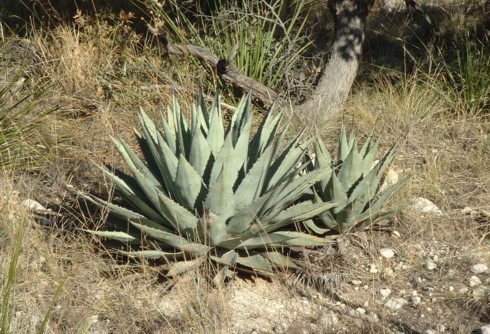
Agave neomexicana in habitat, Guadalupe Mountains, Texas.
|
A. neomexicana - Mescal. This species originates in west Texas and southeast New Mexico at elevations from about 4,500 to 8,500' (in Texas, it grows all the way to the very top of the Guadalupe Mountains). Frequently offsetting rosettes mature at 2 - 3' wide: it looks like a slightly less chunky version of A. parryi, to which it is obviously closely related. A. neomexicana has slightly thinner leaves than A. parryi and sometimes a more pale color. Some forms have intense silver coloration or exceptional spination. Easily grown but not quite as forgiving of excessive moisture as A. parryi, it will grow throughout the Pacific Northwest with excellent drainage. It is one of the very hardiest Agaves (perhaps to -25°F), and is successful in Denver, Colorado.
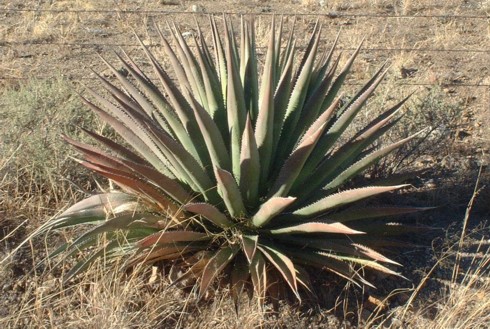
Agave palmeri in habitat near Chiricahua National Monument, Arizona.
|
A. palmeri. This species is common over a large area of northwestern Mexico, and is also found in southern Arizona and southwestern New Mexico at moderate elevations, especially in moister areas. A variable plant, it is usually seen as solitary or with just one or two offsets. The mature rosettes may be anywhere from 3 - 7' across, and the leaves, which have closely set teeth, may be green, green-grey or blue-green. In cultivation it appreciates some summer water. It is one of the easiest Agaves to grow and will endure temperatures down to 0°F, or somewhat lower in very dry climates.
A. parryi - Mescal. This species has a wide distribution throughout Arizona, New Mexico, and throughout various mountain ranges in western Mexico. It is usually found at moderate to high elevations (to 9,200' in Arizona's Chiricahua Mountains!), frequently in clearings in pine-oak woodland, and sometimes in very cold areas that are snow-covered in winter.

Agave parryi in habitat near Stoneman Lake, Arizona.
|
It forms attractive, tight rosettes of many thick, blue or blue-green leaves with back margins and spination. Individual rosettes are usually around 3' wide and usually spread from offsets. One of the most versatile species for gardens, it tolerates sun or partial shade (preferring a little shade in the hottest climates), and needs some summer irrigation to look its best. It is represented by the typical form, which may be hardy to as low as -20°F depending on the provenance, and the following varieties, all of which have excellent ornamental appeal. The var. cousei occurs mostly south of the Flagstaff, Arizona area at quite high elevations (to as high as 8,000'). It forms smaller rosettes than the typical form, with more silvery leaves, and is hardy to at least -25°F. The var. huachuensis comes from the Huachuca Mountains in southern Arizona and a few nearby mountain ranges. It has larger rosettes to 4' across, with more numerous leaves of a usually more grey color, and is less cold hardy, perhaps to about 5°F. The var. truncata is found much farther south in Durango and Zacatecas, Mexico. Usually considered the best ornamental form, it has tight rosettes of very broad leaves with rounded ends (except for the long, curved black spine at the tip), and perpetuates itself from offsets very prolifically. It thrives on ample water, but alas, it is much less cold hardy than other forms, experiencing some damage around 22°F (mature, established plants may survive down to 15°F).
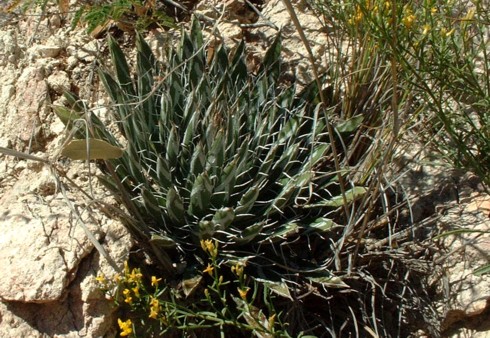
Agave parviflora in habitat, Atascosa Mountains, Arizona.
|
A. parviflora. This small species comes from a restricted area of southern Arizona and just across the border in Mexico. It has small, dark green leaves with white markings and filaments. Individual rosettes are usually about 5" wide, and offset prolifically. An exquisite plant for containers, rockeries, or the front of a desert garden border, it does well west of the Cascades and has even flowered in western Washington. Hardy to 5°F.
A. scabra. Native to south Texas and a large area of northeastern Mexico, this species exhibits great variation but always has rough (scabrous) leaf surfaces. Usually silvery or bluish, its rosettes may be 3 - 5' wide with a prominent terminal spine. It frequently hybridizes with other species in the wild, and some superior garden forms have been selected. A moderate grower, it is easy to cultivate in favorable parts of the Pacific Northwest given very well drained soil. Hardiness varies but usually ranges from about 5 - 15°F - possibly much lower in very dry areas.
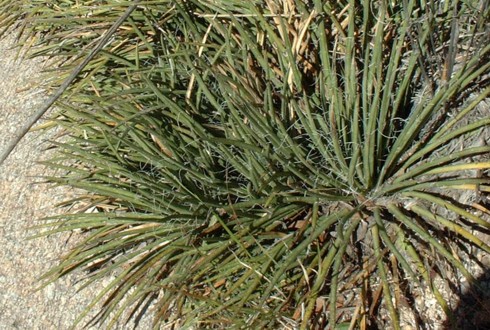
Agave schottii in habitat, Catalina Mountains, Arizona.
|
A. schottii. Coming from various mountain ranges of southern Arizona and northwestern Mexico, this species forms large colonies of rosettes of narrow, deep green, spine-tipped leaves. Interestingly, it also has powerfully fragrant flowers, which are produced when the plants are relatively young (in Agave years). The var. trealsei is like a 'giant form' of A. schottii, being much larger in all its parts. It comes from a few mountains in southern Arizona. Although not commonly cultivated, both forms are very easily grown, versatile desert garden plants and can endure temperatures down to at least -5°F, probably lower east of the Cascades.
A. shawii. A very attractive species from coastal extreme southern California and northwestern Baja California, Mexico. 2 - 3' wide, tight rosettes of numerous broad, toothy, thick green leaves almost seem to form small trunks.

Agave shawii subsp. shawii in habitat, Torrey Pines State Park, California.
|
These offset prolifically: mature plants can be 10' across. The subsp. goldmaniana occurs farther south and is better suited to dry conditions, but inferior in form and not very frost hardy. A. shawii grows right by the Pacific Ocean in the wild, and should be well adapted to the immediate coast here, frost permitting. It is reported to be hardy to about 20 - 25°F, but I wonder whether it has really been given a fair trial in colder, maritime climates yet. Where not hardy, it is also an excellent choice for a container.
A. toumeyana. Coming from a restricted area of the mountains of Central Arizona, this species has narrow, green leaves with white marginal filaments. It forms small rosettes about 8 - 10' across, which offset to form large colonies. The subsp. bella is one of the most attractive small Agaves, having more compact, dense rosettes of shorter leaves. Both forms are easily grown, preferring some summer water, and can endure temperatures down to around 0°F.

Agave toumeyana subsp. bella, UC Berkeley Botanic Garden, Berkeley, California.
|
A. utahensis. No Agave is found in the wild farther north than this species from northern Arizona, southern Utah, southern Nevada and eastern California, where it usually grows at moderate elevations. It generally spiny, with dark green leaves and predominantly white or grey (sometimes black) margins and spination, and is represented by the following subspecies and varieties. The primary form utahensis is a low growing plant with rosettes usually no more than 1 - 1 ½' across and high, which offset to form large clumps. The subsp. kaibabensis from north central Arizona develops larger, often solitary rosettes with numerous leaves sometimes exceeding 18" long. The variety eborispina from Nevada and California has smaller rosettes, the leaves of which have exceptionally pronounced white teeth and a long, distinctive, papery-white terminal spine: they look like they are made entirely of teeth. The variety nevadensis forms small rosettes usually under 6" across, each with strongly outward pointing leaves that causes the rosettes to appear as though they are each 'looking' in a different direction.

Agave utahensis var. nevadensis in habitat in southern Nevada.
|
All forms of A. utahensis are fabulous garden subjects under the right conditions. They are best adapted to very harsh climates and may have difficulty in wet climates. Rainy gardens are especially unsuitable for var. nevadensis and var. eborispina: the other two are easier to maintain. On the other hand, var. nevadensis and var. eborispina do splendidly in the driest areas of eastern Washington and Oregon with no irrigation. A. utahensis is very cold-hardy, to around -15°F or lower. The hardiest form is probably subsp. kaibabensis, which also forms very impressive rosettes: it deserves wider use in cold climate desert gardens, as well as west of the Cascades.
A. weberi. Coming from a few areas of south Texas and northeastern Mexico, this large Agave is similar to A. americana it its size, hardiness, and uses in the garden. Compared to this species, it has a more refined look with thinner leaves and much no real marginal teeth. It is not fussy about soil and is a vigorous grower in most any climate. At least one rare variegated form exists. Young plants are damaged around 26°F, but mature plants may be hardy to 10 - 15°F.

Agave utahensis in habitat near Peach Springs, Arizona.
|
American Agaves by State
Arizona: A. americana (doubtful), A. x arizonica, A. chrysantha, A. delamateri, A. mckelveyana, A. murpheyi, A. palmeri, A. parryi subsp. huachucensis, A. parryi subsp. parryi, A. parryi var. cousei, A. parviflora subsp. parviflora, A. phillipsiana, A. schottii var. schottii, A. schottii var. treleasei, A. toumeyana subsp. bella, A. toumeyana subsp. toumeyana, A. utahensis subsp. utahensis, A. utahensis var. kaibabensis.
California: A. deserti subsp. deserti, A. deserti subsp. simplex, A. shawii subsp. shawii, A. utahensis subsp. nevadensis, A. utahensis var. eborispina.
Florida: A. decipiens, A. neglecta.
Nevada: A. utahensis subsp. nevadensis, A. utahensis var. eborispina
New Mexico: A. gracilipes, A. lechuguilla, A. neomexicana, A. palmeri, A. parryi subsp. parryi.
Texas: A. gracilipes, A. havardiana, A. lechuguilla, A. lophantha, A. neomexicana, A. scabra, A. weberi (doubtful).
Utah: A. utahensis subsp. utahensis.
Back to Articles |
Home
|

















